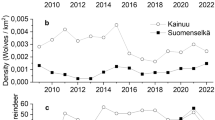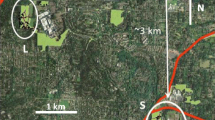Abstract
Survival rate is an essential component of population dynamics; therefore, identification of variation in mortality rates and the factors that influence them might be of key importance in understanding why populations increase or decrease. In Denmark, the Little Owl Athene noctua, a species strongly associated with anthropogenically modified landscapes, is declining fast and may soon face extinction. The population decline is ultimately associated with reduced survival of independent offspring, but reduced survival rates of adults may possibly contribute to the observed decline. To explore the causes of current survival rates, we estimated age- and season-specific survival rates and causes of mortality in Danish Little Owls on the basis of ringed birds 1920–2002, radio tagged adult and juveniles 2005–2008 and nest surveys 2006–2008. We estimate that 32 % of all eggs fledge and survive to 2 weeks post hatching (age of ringing) and 47 % of the nestlings from ringing to fledging. Fifty-five percentage of the radio-tracked fledged young survived to dispersal, i.e. a total survival rate from egg to dispersal of 8 %. Analyses of combined ringing and radio tracking data showed a lower survival rate in the 1st year of life and a much lower rate in the first 3 months of life. Furthermore, the analyses indicated that survival was lower in the winter months for ringing data during 1920–2002 but not for radio-tagged owls during 2005–2008 that experienced the highest mortality rates during the breeding season. In radio-tagged adults and fledged juveniles, accidents in buildings and other human infrastructures were responsible for two-thirds of all fatalities. Anthropogenic habitats currently comprise the nesting and roosting habitats for the last Danish Little Owls. The accidental deaths associated with these might to some extent be considered as a contributing factor to the present negative population growth rate of this population.
Zusammenfassung
Saisonale Überlebensraten und Ursachen für Sterblichkeit beim Steinkauz ( Athena noctua ) in Dänemark
Überlebensraten sind ein grundlegender Bestandteil der Populationsdynamik. Deshalb ist die Untersuchung der Schwankungen von Überlebensraten sowie der diese Raten beeinflussenden Faktoren für das Verständnis von Schwankungen der Populationsgrößen von besonderer Bedeutung. In Dänemark hängt der Steinkauz (Athena noctua) sehr von den vom Menschen veränderten Landschaften ab, sein Vorkommen geht rasch zurück, und er könnte schon bald vor dem Aussterben stehen. Letztendlich hängt das Überleben der Population davon ab, wie viele unabhängige Jungtiere überleben; aber auch eine geringere Überlebensrate der Adulten könnte möglicherweise zum beobachteten Rückgang dieser Art führen. Für die Untersuchung der Ursachen der derzeitigen Überlebensraten schätzten wir die alters- und saisonspezifischen Überlebensraten sowie die Sterblichkeit dänischer Steinkäuze anhand von beringten Vögeln (1920–2002), von mit Sendern versehenen Adulten und Jungvögeln (2005–2008) und anhand von Nestuntersuchungen zwischen 2006 und 2008. Wir schätzen, dass aus 32 % aller Eier Junge schlüpfen und jedenfalls zwei Wochen (das Alter der Beringung) überleben, wie auch 47 % aller geschlüpften Vögel von der Beringung bis zum Flüggewerden. Von den mit Sendern versehenen Jungvögeln überlebten 55 % bis zum Ausfliegen. Das heißt, die Überlebensrate insgesamt betrug vom Ei bis zum Ausfliegen der Jungvögel 8 %. Die Kombination der Ringfunddaten mit denen des radio-tracking zeigte für das erste Lebensjahr eine nur etwas, für die ersten drei Lebensmonate aber eine wesentlich niedrigere Überlebensrate. Außerdem wiesen die Analysen darauf hin, daß für die Ringfunde 1920–2002 die Überlebensrate in den Wintermonaten geringer war, aber nicht für die von 2005 bis 2008 mit Sendern versehenen Tiere; diese zeigten während der Brutzeiten die höchsten Sterblichkeitsraten. Bei den Adulten und ausgeflogenen Jungtieren mit Sendern waren Unfälle an Gebäuden und anderen von Menschen gemachten Strukturen für zwei Drittel aller Todesfälle verantwortlich. Anthropogene Habitate beinhalten derzeit Nist- und Ruheplätze für die letzten dänischen Steinkäuze, und die damit zusammenhängenden Unfalltode tragen vermutlich in gewissem Grad zur derzeitigen negativen Wachstumsrate dieser Population bei.




Similar content being viewed by others
References
Anders AD, Dearborn DC, Faaborg J, Thompson FR (1997) Juvenile survival in a population of neotropical migrant birds. Conserv Biol 11:698–707
Brown JH (1984) On the relationship between abundance and distribution of species. Am Nat 124:255–279
Burnham KP, Anderson DR (2002) Model selection and multimodel inference: a practical information-theoretic approach, 2nd edn. Springer, Berlin
Caughley G, Gunn A (1996) Conservation biology in theory and practice. Blackwell, Cambridge
Cooch E, White G (2007) Using MARK–a gentle introduction. http://www.phidot.org/software/mark/docs/book/markbook.exe. Retrieved 23 November 2008
Davies JM, Restani M (2006) Survival and movements of juvenile burrowing owls during the postfledging period. Condor 108:282–291
Donald PF, Green RE, Heath MF (2001) Agricultural intensification and the collapse of Europe’s farmland bird populations. Proc R Soc B 268:25–29
Exo KM, Hennes R (1980) Beitrag zur Populationsökolige des Steinkauzes (Athene noctua)–eine Analyse deutscher und niederländischer Ringfunde. Vogelwarte 30:162–179
Grell MB (1998) Fuglenes Danmark. Gad, Copenhagen
Haskel D (1994) Experimental evidence that nestling begging behaviour incurs a cost due to nest predation. Proc R Soc B 257(1349):161–164
Hazler KR (2004) Mayfield logistic regression: a practical approach for analysis of nest survival. Auk 121:707–716
Jacobsen LB (2006) Ynglebestanden af Kirkeugle Athene noctua i Vendsyssel og Himmerland 1981–2000. Dansk Orn Foren Tidsskr 100:35–43
Kenward RE (2001) A manual for wildlife radio tagging. Academic Press, New York
Le Gouar PJ, Schekkermnan H, van der Jeugd HP, Boele A, van Harxen R, Fuchs P, Stroeken P, van Noordwijk A (2011) Long-term trends in survival of a declining population the case of the Little Owl (Athene noctua) in the Netherlands. Oecologia 166:369–379
Lebreton JD, Burnham KP, Clobert J et al (1992) Modeling survival and testing biological hypothesis using marked animals: a unified approach with case studies. Ecol Monogr 62:67–118
McFadzen ME, Marzluff JM (1996) Mortality of prairie falcons during the fledging-dependence period. Condor 98:791–800
Newton I (2004) The recent declines of farmland bird populations in Britain: an appraisal of causal factors and conservation actions. Ibis 146:579–600
Ortega E, Mañosa S, Margalida A, Sánchez RS, Oria J, González LM (2009) A demographic description of the recovery of the vulnerable Spanish imperial eagle Aquila adalberti. Oryx 43:113–121
Overskaug K, Bolstad JP, Sunde P, Øien IJ (1999) Fledgling behaviour and survival in northern tawny owls. Condor 101:169–174
Rohner C, Hunter DB (1996) First-year survival of great horned owls during a peak and decline of the snowshoe hare cycle. Can J Zool 74:1092–1097
Schaub M, Ullrich B, Knötzsch G, Albrecht P, Meisser C (2006) Local population dynamics and the impact of scale and isolation: a study on different Little Owl populations. Oikos 115:389–400
Schaub M, Aebischer A, Gimenez O, Berger S, Arlettaz R (2010) Massive immigration balances high anthropogenic induced mortality in a stable eagle owl population: lessons for conservation. Biol Conserv 143:1911–1918
Schönn S, Scherzinger W, Exo KM, Ille R (1991) Der Steinkauz. Ziemsen, Wittenberg Lutherstadt
Sunde P (2005) Predators control post-fledging mortality in tawny owls, Strix aluco. Oikos 110:461–472
Sunde P, Thorup K, Jacobsen LB, Holsegård-Rasmussen MH, Ottesen N, Svenné S, Rahbek C (2009) Spatial behaviour of little owls (Athene noctua) in a declining low-density population in Denmark. J Ornithol 150:537–548
Thorup K, Sunde P, Jacobsen LB, Rahbek C (2010) Breeding season food limitation drives population decline of the Little Owl Athene noctua in Denmark. Ibis 52:803–812
Todd LD, Poulin RG, Wellicome TI, Brigham RM (2003) Post-fledging survival of burrowing owls in Saskatchewan. J Wildl Manag 67:512–519
Tucker GM, Heath MF (1994) Birds in Europe: their conservation status. Birdlife International, Cambridge
Ullrich B (1980) Zur Populationsdynamik des Steinkauzes (Athene noctua). Die Vogelwarte 30:179–198
Van Nieuwenhuyse D, Génot JC, Johnson DH (2008) The little owl. Conservation, ecology and behaviour of Athene noctua. Cambridge University Press, Cambridge
White GC, Burnham KP (1999) Program MARK: survival estimation from populations of marked animals. Bird Study 46:120–139
Acknowledgments
The study was funded by the Villum Kann Rasmussen Foundation.
Author information
Authors and Affiliations
Corresponding author
Additional information
Communicated by P. H. Becker.
Electronic supplementary material
Below is the link to the electronic supplementary material.
Rights and permissions
About this article
Cite this article
Thorup, K., Pedersen, D., Sunde, P. et al. Seasonal survival rates and causes of mortality of Little Owls in Denmark. J Ornithol 154, 183–190 (2013). https://doi.org/10.1007/s10336-012-0885-4
Received:
Revised:
Accepted:
Published:
Issue Date:
DOI: https://doi.org/10.1007/s10336-012-0885-4




